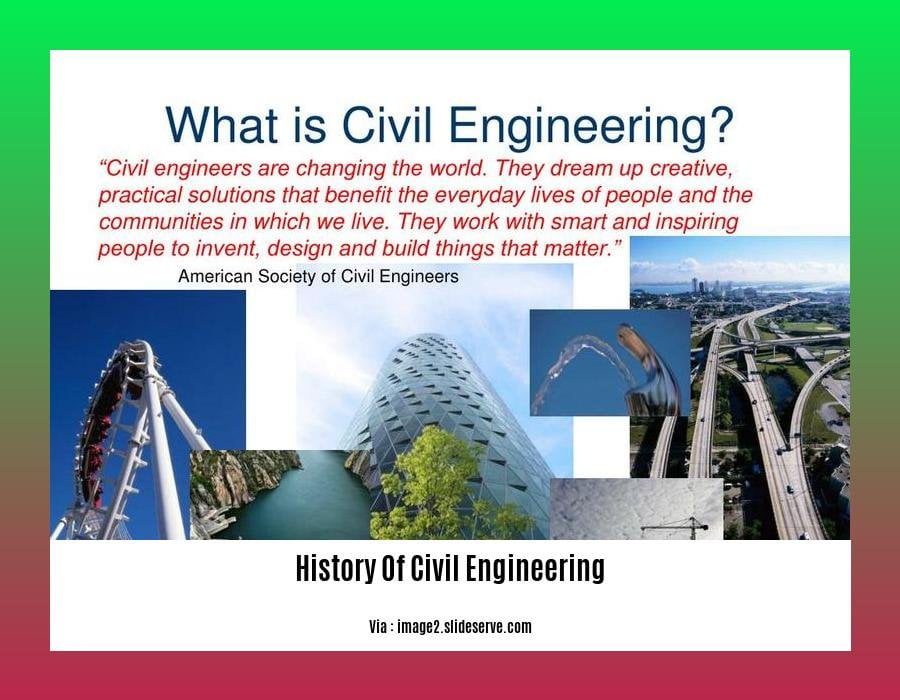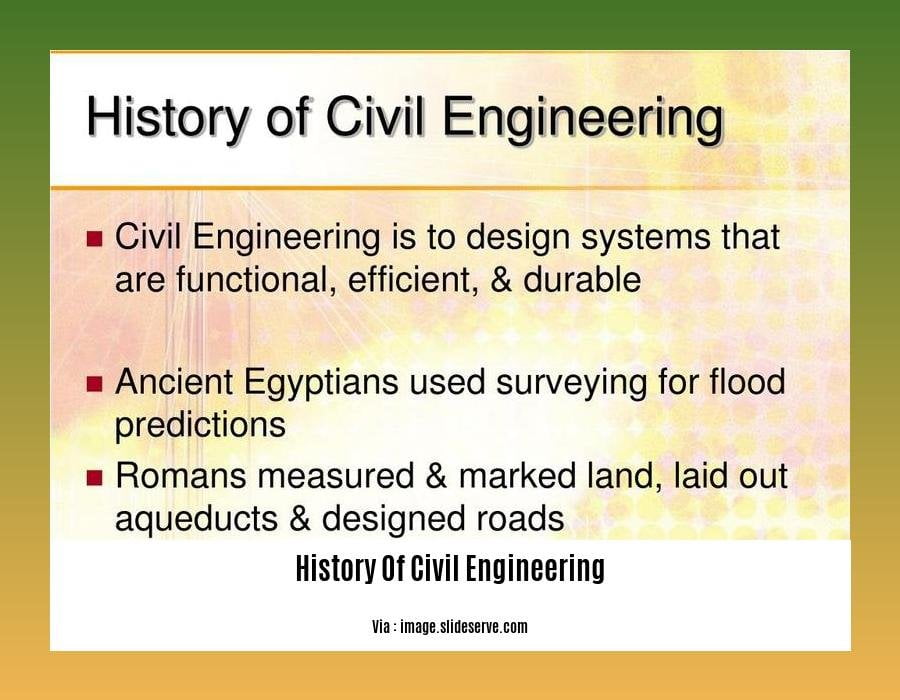Embark on a captivating journey through the annals of human ingenuity as we delve into the rich history of civil engineering. From the awe-inspiring feats of ancient civilizations to the transformative innovations of the Industrial Revolution, this exploration unveils the profound impact of engineering on shaping our built environment, connecting communities, and propelling societal progress. Join us as we trace the evolution of human ingenuity through the lens of civil engineering, a field that has indelibly transformed the world we inhabit—[Tracing the Evolution of Human Ingenuity: A Journey Through the History of Civil Engineering].
Key Takeaways:
- Civil engineering is the design and execution of structural works that serve the public (e.g., dams, bridges).
- It emerged as a separate discipline in 18th century France with the establishment of the Bridge and Highway Corps.
- John Smeaton, the first self-proclaimed civil engineer, made notable contributions, including designing Eddystone Lighthouse.
- Civil engineering has three main functions: design, construction, and management.
- Design involves creating plans and specifications for structures.
- Construction entails carrying out the physical construction of structures.
- Management involves overseeing the construction process and ensuring project completion on time and within budget.
- Feasibility studies are conducted before major projects to assess objectives and potential plans, considering technical, economic, and environmental factors.
- Site investigations are performed to assess the suitability of a project site, including soil conditions, groundwater levels, and potential hazards.
History of Civil Engineering

Throughout the annals of human history, the quest to conquer nature and harness its power has been the driving force behind the evolution of civil engineering. From the awe-inspiring pyramids of Egypt to the intricate water systems of ancient Rome, the history of civil engineering is a testament to humanity’s unceasing pursuit of progress and innovation.
Early Civilizations
The seeds of civil engineering were first sown in the fertile river valleys of Mesopotamia and Egypt. Necessity, the mother of invention, fueled the construction of canals and dikes to control the flooding of mighty rivers like the Nile and the Tigris. These early hydraulic feats enabled the rise of agriculture, providing sustenance to growing populations and laying the foundation for the development of urban centers.
Ancient Rome
The Romans, with their penchant for grandeur and practicality, elevated civil engineering to an art form. Their iconic aqueducts, transporting water from distant sources to urban centers, were marvels of engineering excellence. The Colosseum, a testament to their structural prowess, has stood the test of time, bearing witness to the enduring legacy of Roman engineering.
The Middle Ages
The Middle Ages witnessed a surge in the construction of castles and cathedrals. These imposing structures, testaments to the ingenuity of medieval engineers, were not merely defensive bulwarks or places of worship; they were also showcases of architectural prowess. Gothic cathedrals, with their soaring spires and intricate stained-glass windows, exemplified the harmonious fusion of engineering and aesthetics.
The Renaissance and Modern Era
With the Renaissance came a renewed thirst for knowledge and experimentation. Leonardo da Vinci, the quintessential Renaissance man, left an indelible mark on civil engineering through his innovative bridge designs and urban planning concepts. The Industrial Revolution sparked unprecedented advancements in construction technologies, culminating in the construction of towering skyscrapers, spanning bridges, and an intricate network of transportation infrastructure.
The Legacy of Civil Engineering
Today, civil engineers continue to push the boundaries of human ingenuity, designing and constructing structures that were once considered impossible. They have tamed rivers with massive dams, connected continents with undersea tunnels, and ventured into the realm of space with futuristic projects like space stations.
The history of civil engineering is a chronicle of human perseverance and innovation. It is a testament to our ability to harness nature’s forces, overcome physical limitations, and shape our world according to our needs and aspirations. As we look to the future, civil engineers will undoubtedly continue to play a pivotal role in shaping the built environment and ensuring the sustainability of our planet.
- History of Claddagh Rings will unravel the beautiful story behind these iconic Irish rings, symbolizing love, loyalty, and friendship.
- Delve into the History of Classical Music, a journey through centuries of musical masterpieces that have shaped the very essence of Western culture.
- Unravel the fascinating History of Clock Towers, exploring their evolution from ancient sundials to magnificent architectural landmarks that have stood the test of time.
The Middle Ages and Civil Engineering

In the tapestry of human civilization, the Middle Ages stand as a radiant chapter of architectural prowess and engineering marvels. During this era, civil engineering evolved from a practical craft to a refined science, ushering in remarkable innovations and transforming the built environment.
Embracing Roman Legacy
The fall of the Roman Empire left behind an enduring legacy of engineering knowledge that profoundly influenced medieval construction practices. Roman advancements in arch construction, vaulting techniques, and road building were eagerly adopted and adapted by skilled craftsmen throughout Europe.
Gothic Masterpieces: Soaring to New Heights
The Gothic cathedrals that graced medieval cities were not merely testaments to religious devotion; they epitomized the zenith of engineering prowess. These awe-inspiring structures, with their delicate ribbed vaults, flying buttresses, and intricate stained glass windows, pushed the boundaries of structural design and challenged the limits of human ingenuity.
Castles: Fortresses of Strength
Medieval castles, with their imposing walls, towers, and moats, were not just defensive structures; they showcased the ingenuity of military engineers. These fortresses, often perched atop strategic hilltops, incorporated advanced defensive features such as machicolations, drawbridges, and portcullises to withstand prolonged sieges.
Bridges: Connecting Communities
Medieval bridges served as vital arteries of transportation, linking far-flung regions and facilitating trade and communication. These structures, skillfully constructed using stone and timber, crossed treacherous rivers and spanned vast chasms, allowing people to traverse once-impassable landscapes.
Water Management Systems: Nurturing Life
Medieval engineers demonstrated their expertise in water management through innovative systems of canals, dams, and aqueducts. These structures controlled and distributed water for irrigation, drinking, and sanitation, sustaining communities and enabling agricultural productivity.
Key Takeaways:
- The Middle Ages witnessed the flourishing of civil engineering, building upon the legacy of Roman expertise.
- Gothic cathedrals showcased the pinnacle of architectural and engineering achievement, with their soaring vaults and intricate buttresses.
- Castles, with their robust fortifications, exemplified the ingenuity of military engineers.
- Medieval bridges connected communities and facilitated trade, demonstrating the importance of transportation infrastructure.
- Water management systems showcased the engineers’ ability to harness and control water resources for various purposes.
References:
- Civil Engineering in the Middle Ages
- Medieval Civil Engineering
The Industrial Revolution and Civil Engineering
Civil engineering, the art of designing and constructing the built environment, has played a pivotal role in shaping human history. Throughout the ages, it has evolved in response to societal needs and technological advancements, reaching new heights of innovation during the Industrial Revolution.
Key Takeaways:
- The Industrial Revolution marked a turning point in civil engineering, driven by technological advancements like the steam engine, iron, and concrete.
- New construction methods and materials enabled the construction of larger and more complex structures that supported the growing industrial economy.
- Civil engineers played a vital role in designing and building bridges, railways, and canals, connecting regions and facilitating trade.
- The Industrial Revolution also brought about advancements in urban planning, as cities grew rapidly to accommodate the influx of workers.
- Civil engineers designed and implemented new infrastructure systems, including water supply, sewage systems, and roads, to improve living conditions in urban areas.
During the Industrial Revolution, the convergence of engineering ingenuity and industrial might transformed the landscape of civil engineering. Steam engines, the workhorses of the era, provided the power needed to drive machinery and propel transportation. Iron, with its superior strength and durability, replaced traditional materials like wood and stone in construction, allowing for taller and more expansive structures. Concrete, a versatile and cost-effective material, revolutionized the construction industry, enabling the rapid construction of bridges, buildings, and other infrastructure.
The Industrial Revolution triggered a surge in infrastructure development to support the burgeoning industrial economy. Bridges, the arteries of transportation, spanned rivers and valleys, connecting cities and regions. Railways, the iron horses of the era, crisscrossed the countryside, transporting goods and people with unprecedented speed and efficiency. Canals, the watery highways of the time, facilitated the movement of goods between inland cities and ports, boosting trade and commerce.
Urban planning, too, underwent a transformation during the Industrial Revolution. As cities swelled with the influx of workers seeking employment in factories, the need for organized and efficient urban environments became paramount. Civil engineers designed and implemented new infrastructure systems, including water supply, sewage systems, and roads, to improve the living conditions and sanitation in rapidly growing urban areas.
The Industrial Revolution left an indelible mark on the field of civil engineering, propelling it into a new era of innovation and progress. The legacy of this period can be seen in the iconic structures and infrastructure systems that continue to serve society today. From the soaring bridges and sprawling railway networks to the intricate water and sewage systems, the Industrial Revolution laid the foundation for the modern built environment we inhabit today.
Relevant URL Sources:
[1] https://www.britannica.com/technology/civil-engineering
[2]
FAQ
Q1: What are some notable ancient civilizations that made significant contributions to civil engineering?
A1: Ancient civilizations like the Egyptians, Romans, and Chinese made remarkable contributions to civil engineering. They built structures like the Great Wall of China, the Roman Colosseum, and the Egyptian pyramids, demonstrating their understanding of engineering principles and construction techniques.
Q2: How did the Industrial Revolution impact the field of civil engineering?
A2: The Industrial Revolution brought about new technologies and materials, such as steam engines, iron, and concrete, revolutionizing civil engineering. These advancements enabled the construction of larger and more complex structures like bridges, railways, and canals, facilitating the growth of the industrial economy and connecting regions.
Q3: What was the role of civil engineering during the Middle Ages?
A3: During the Middle Ages, civil engineering saw the adoption and adaptation of Roman techniques. Gothic cathedrals, castles, and fortifications showcased innovative structural systems and architectural styles, demonstrating the continued evolution of civil engineering practices.
Q4: What are some key developments in civil engineering during the 20th century?
A4: The 20th century marked the rise of modern civil engineering, characterized by the development of new construction methods, prefabricated components, and specialized fields. Skyscrapers, long-span bridges, and dams were constructed using advanced engineering principles and technologies, transforming the landscape of civil infrastructure.
Q5: How has civil engineering contributed to the development of modern infrastructure?
A5: Civil engineering has played a pivotal role in shaping modern infrastructure. From roads and bridges to water treatment plants and skyscrapers, civil engineers have designed and constructed the structures that support our daily lives. Their expertise has enabled the efficient movement of people and goods, access to clean water, and the creation of livable urban environments.
- Sept 31 Myth: Unveiling Calendar Secrets - March 18, 2025
- How Long & Till December 18, 2025: Accurate Countdown Guide - March 18, 2025
- Discover Japanese Artists: A Complete History - March 18, 2025
















